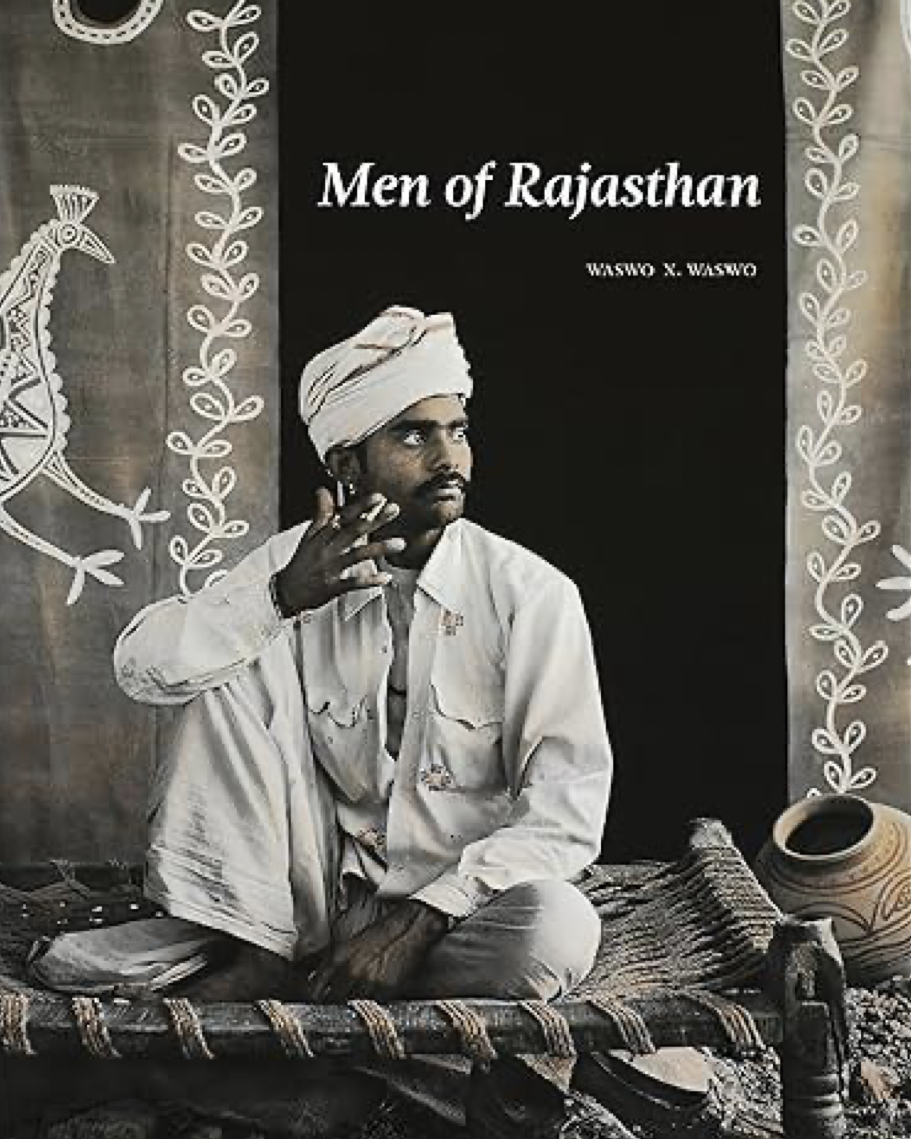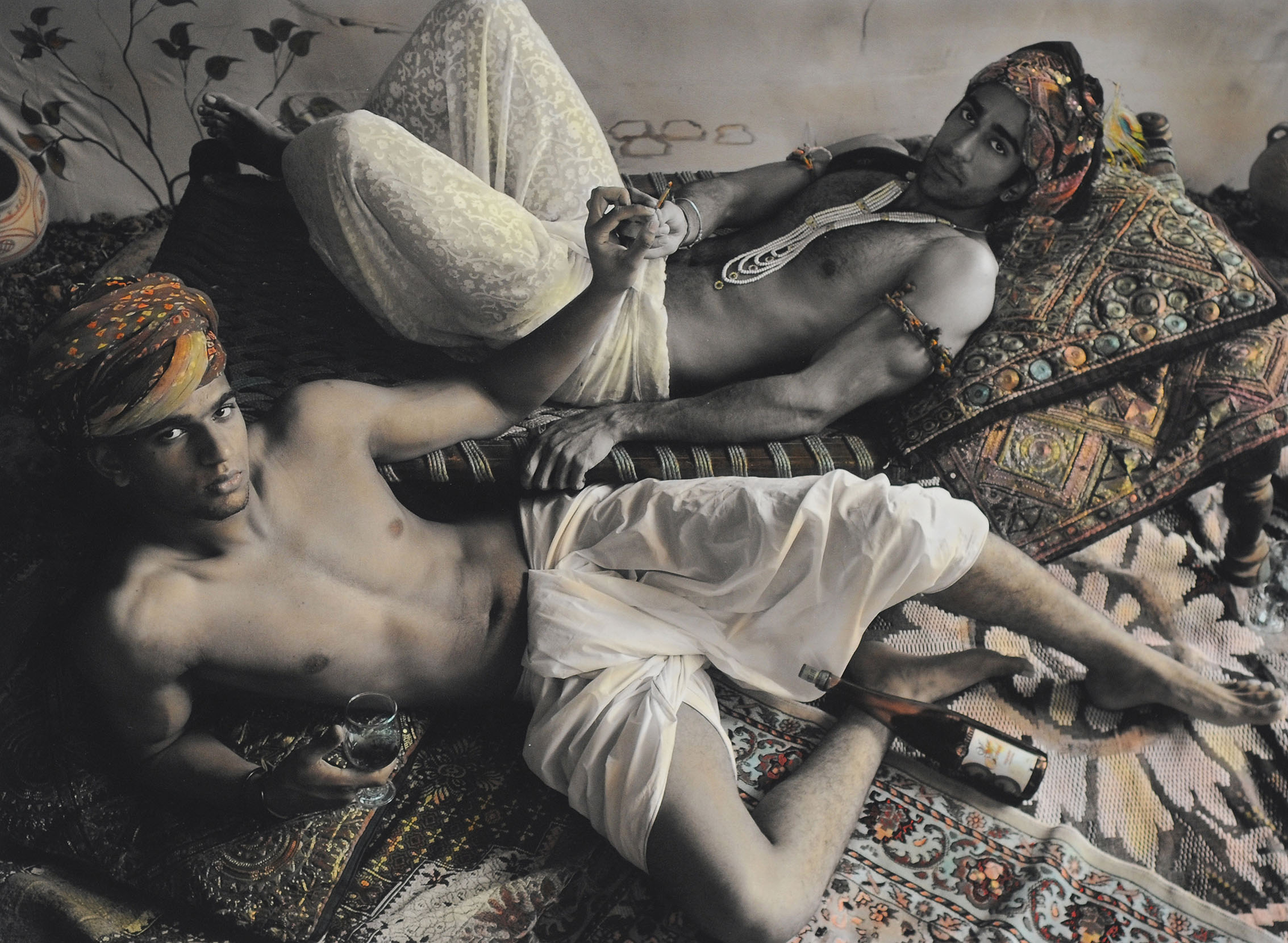“When you first look at my pictures you know what you’re seeing. Then you realise what you first saw is not correct and you’re forced to look at them again, which leaves you with this strange feeling that you’re caught in the middle.”— Waswo X. Waswo

Waswo X. Waswo | Image courtesy of the artist, Meropie Mitrou and Open Magazine
Waswo X. Waswo (b. 1953, Milwaukee, United States) is an American photographer and writer who has lived and travelled in India for over 20 years, and he has made his home in Udaipur, Rajasthan for over a decade. He is best known for his hand-painted black and white photographs of people from the streets of Rajasthan, shot against dramatic cloth backgrounds in his village studio. He has had a long history of collaborating with traditional miniature painters where he lives in Udaipur, Rajasthan. Collaborating with a variety of traditional miniaturists, Waswo’s paintings express the experience of being an outsider; flipping perspectives and causing the viewer to question the space that separates the insider from the interloper.

Waswo X. Waswo, Prayer for Unity, 2020 | Image courtesy of the artist and Gallery Espace
As a child, Waswo loved painting. At college, he studied creative writing and journalism with dreams of becoming an author. After college, when he met Edward Farber, a photographer of the Milwaukee newspaper, he was attracted by the direct way visual art communicated. Waswo studied at the University of Wisconsin-Milwaukee, The Milwaukee Center for Photography, and Studio Marangoni, The Centre for Contemporary Photography in Florence, Italy. He published several books including India Poems:The Photographs in 2006, Men of Rajasthan in 2011, Photowallah in 2016, and Gauri Dancers in 2019. Waswo’s works are held in collections at The Haggerty Museum of Art, Marquette University; The Asian Art Museum, San Francisco; The William Benton Museum of Art, University of Connecticut; The Museum of Art and Photography, Bangalore; Delhi Art Gallery.

Waswo X. Waswo, the book “Men of Rajasthan” published by Serindia Publications, UK in 2011 | Image courtesy of the artist
Waswo is also a collector of Indian printmaking. The first Indian print he bought was a beautiful etching by Bhupen Khakhar. In 10 years, he built a huge collection of over 250 prints. His collection has been shown at the India Habitat Centre, followed by exhibitions at NGMA Bangalore and Mumbai. Later, he donated his collection to the University of Lowa Stanley Museum of Art.
Collaboration and humanity are his creative practice
“I have always taken photos based on pictorialism, I like beautiful landscapes and common people – I like them as people. They have a lot of self-worth and awareness of that self-worth too.” Waswo first came to India in 1993. In 2006, he bought the home in Udaipur as he wanted to work with the craftsmen there. “I see one of my jobs as finding what people are good at and trying to incorporate that into my work.”

Waswo X. Waswo and R.Vijay | Image courtesy of the artists and Johny ML
Waswo works with a small team of collaborators in Udaipur. The hand-coloured photographic portraits co-created with photo-colourist Rajesh Soni, and the series of contemporary miniatures, conceptualized by Waswo and realized with the help of Udaipur-based miniaturist R. Vijay. They all agreed that “the purpose of art is to reveal and explore humanity. Humanizing in a sensitive way has a social purpose in and of itself.”

Raiesh Soni | Image courtesy of the artist
“A photograph is the image captured on film and a print is the physical copy. Making the print is very important to me, it constitutes 50% of what makes a good photograph. That is why making a good print matter. And hand-painted photography was how people used to colour black and white photographs. I wanted to combine these two lost arts and have black and white prints painted by hand” When Waswo first started creating work in India, he was a photographer with a Rolleiflex and a dark room he had built in Udaipur. The time had come to go digital and Waswo bought an Epson 2700, the first high-end digital printer in Rajasthan. “I met Rajesh Soni around this time, he saw the black and white photos I was printing up and said he could paint them.”
People of Udaipur, Rajasthan with Hindu myths as the subject in his photographs
“To this day I never see my work as individual statements, but rather, portions of a much larger tale.” The hand-coloured photos of villagers is the ongoing series since 2006. From the roadside fruit seller to the local street performer, the residents of the village where Waswo has set up his studio are his models.

Waswo X. Waswo, Feathers for Sale, 2008 (hand-coloured by Rajesh Soni) | Image courtesy of the artist
“It is like theatre, a co-operative performance. We term the people who pose for us as models.” Waswo directs the whole, as the creative director. The process of taking the photo itself is theatrical with elaborate backdrops painted on linen, vintage props and costumes. Post the digital production and printing, the photos are meticulously hand-tinted by Rajesh Soni.

Waswo X. Waswo, The Flower, 2015 (hand-coloured by Rajesh Soni) | Image courtesy of the artist
Waswo’s photographs playfully examine the worlds of colonial ethnographic documentation and the fantastical make-believe of early photo studios. They range from single figure shots to theatrical tableaus, and reference from Hindu myths and contemporary rituals to everyday life.

Waswo X. Waswo, New Myths First Incarnation the Eleventh, 2009 (hand-coloured by Rajesh Soni) | Image courtesy of the artist and Sunpride Foundation
In the series “New Myths, First Incarnations”, Waswo draws from stories in Hindu mythology and stages the likes of Krishna and Hanuman in unexpected settings.

Waswo X. Waswo, New Myths Second Incarnation the Fourth (Hanuman Series), 2010 (hand-coloured by Rajesh Soni) | Image courtesy of the artist and Asian Art Museum of San Francisco
In the series “New Myths, Second Incarnation”, Waswo wanted his Hanuman to look like a real fighter, an individual defined by belief that is channeled into physical power, examining vague and ever-disputed lines of what it means to be a man.

